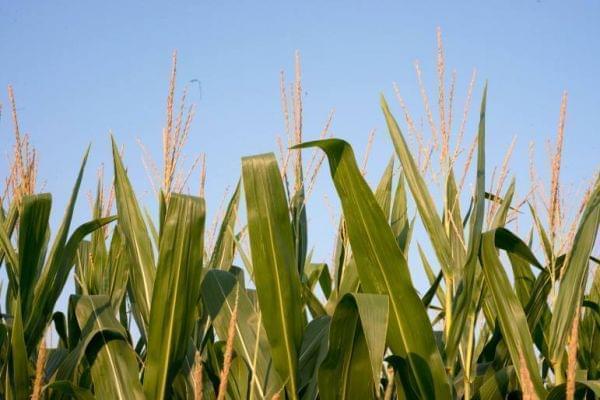Monsanto Claims News GMO Corn Produces Bigger Ears

A foot-long ear of corn would grow an extra inch or two. And while that seems like a small gain, it’s a big deal considering corn is used for everything from animal feed and fuel to soda and cereal. Midwest Center For Investigative Reporting
A foot-long ear of corn would grow an extra inch or two. And while that seems like a small gain, it’s a big deal considering corn is used for everything from animal feed and fuel to soda and cereal.
Joe Walsh, Monsanto’s North American Corn Technology lead, said, "The one thing that farmers continually ask us for are products which deliver more yield for them. This product, in essence, provides and increased ear biomass for corn. And the result of that is that the farmers get an improved harvest and higher yields."
Farmers looking to start growing the larger ears shouldn’t get too excited just yet, though. Walsh said the product is in an advanced development phase and still years away from commercial release.
"We meticulously go through these products for many years. I would say, you know, where it’s currently at in our pipeline, it still needs to continue to move through the process."
Records show Monsanto is already trying to get regulatory approval for its higher yielding corn, dubbed variety 87403.
In the United States, GMOs are regulated by what's called the coordinated framework for biotechnology, an oversight system split between federal agencies like the USDA, EPA and FDA.
Monsanto submitted the necessary paperwork a year ago, and got an early thumbs up in July when the USDA supported deregulation.
That wasn't a surprise to Steve Suppan. He's a senior policy adviser for the Institute for Agriculture and Trade Policy.
"The 1986 framework for the regulation of agricultural biotechnologies is not really a regulatory framework. Rather, it’s a deregulatory framework," said Suppan.
A Midwest Center for Investigative Reporting analysis found the USDA has approved about three out of every four requests for deregulation it has ever received.
"I would call it a nonexistent regulatory system. My assumption is that the Monsanto variety 87403 will be granted non-regulatory status," said Suppan.
Some agricultural economists caution bigger corn isn’t exactly what America’s farmers need.
Record harvests in recent years have resulted in a large corn surplus.
That surplus has slashed corn prices and made it difficult for farmers to stay out of the red.
After hitting $8 a bushel during the 2012 drought, a bushel of corn now sells for less than $4.
That’s central Illinois farmer Paul Jeschke, who with his wife grows equal parts corn and soybean on 4,000 acres.
Jeschke calculates he spends about $530 an acre to plant his corn crop, a total that factors in fertilizer, seed, equipment, fuel and other expenses.
"The number one challenge for corn growers today is profitability," said Jeschke, "Right now, we’re looking at retail prices at where we sell our corn that is below the cost of production, unless you ended up growing 280 bushels an acre or something like that, which we aren’t doing."
Jeschke says he pays up to $150 an acre for seed alone.
"A lot of people complain about the seed and how expensive it’s gotten to be," said Jeschke, "There’s cheaper seed out there, but the reason we’re planting the expensive stuff is because it does yield better."
A few agriculture trade groups also worry the new corn might trigger trade disruptions if it isn’t internationally approved, as countries regulate GMOs differently.
That's what happened in 2013. Farmers suffered devastating losses after China stopped shipments of U.S. corn because they included a GMO corn produced by Syngenta… which China hadn’t approved.
The National Grain and Feed Association says the ban cost U.S. producers as much as $3 billion.
Monsanto said in its deregulation paperwork for the new corn seed that it will secure foreign approval in all major corn markets before a commercial release.
But Suppan says there’s no guarantee.
"You’re pretty much taking the applicant on its word," said Suppan.
Despite economic concerns, Jeschke says a lot of farmers would be eager to test out Monsanto’s bigger corn, pointing out they’ll soon be asked to feed a growing worldwide population that the United Nations estimates will near 10 billion in less than four decades.
"There’s going to be bumps in the road from a profitability standpoint, times of surplus. But, ultimately, our goal to feed those people has to be that we’ll continue to research these new and improved methods of increasing out food production," said Jeschke.
Plus, he says, no farmer brags about having the lowest yields.
Links
- GMOs, Monsanto And The Fight Against Climate Change
- Monsanto Inches Closer To Biggest Biotech Launch In Company’s History
- Should Farmers Give John Deere And Monsanto Their Data?
- Monsanto President Talks About GMO Labeling
- Farmer’s Fight With Monsanto Reaches The Supreme Court
- Taiwanese Delegation Agrees To Buy Billions In Illinois Corn and Soybeans

